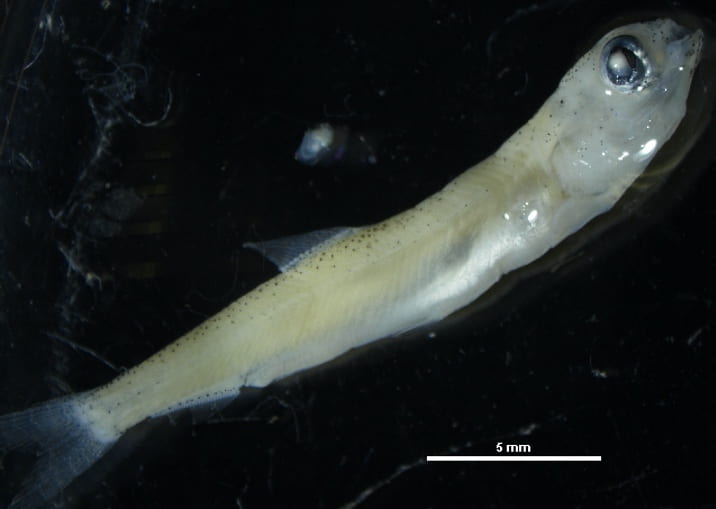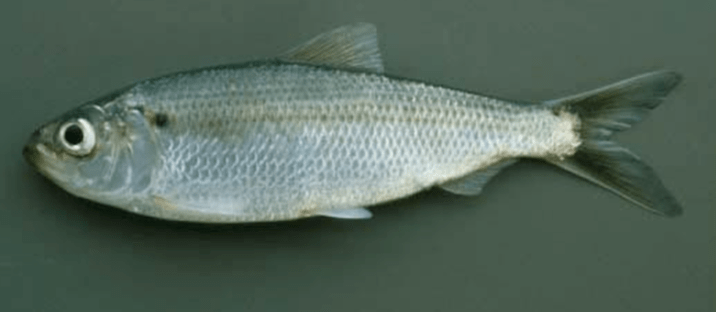Key Characteristics:
- Pre-anal myomeres far greater than post-anal, similar ratios to Catostomidae.
- Pointy mouth usually ends terminally.
- Very little pigment, mostly found near face and head.
- Digestive tract long and feathery, visible along belly of fish.
- Anal fin rays can be counted to determine species. Under 20 for alewife, 20+ for gizzard shad. Those are the two species in Lake Michigan. Total fin ray number don’t come in until the fish is at least 10 mm so under 20 might not mean an alewife if the fish is very small.

Larval Alewife. 23 mm. United States Fish Wildlife Service. Green Bay Harbor, WI. Adam Dziewa. 2018.

Larval Alewife. 27 mm. United States Fish Wildlife Service. Green Bay Harbor, WI. Adam Dziewa. 2018.
- Body not elongated, eel-shaped, round in transverse section, uniformly pigmented (1B)
- Chin barbels absent (3B)
- Snout short, its length usually less than 10% TL; median fins otherwise (5B)
- Median fins or finfolds showing distinct separation (7B)
- No adipose fin, or demarcation of one, in finfold (10B)
- Preanal myomeres greater than or equal to postanal myomeres (14A)
- Preanal myomeres significantly greater than postanal myomeres (difference greater than five myomeres) (15B)
- Postanal myomeres usually less than or equal to 10 (26A)
- Preanal length 77 – 89% TL, ratio of preanal to postanal myomeres greater than 5.0 (27A)
- Clupeidae – Herrings
Adult History
- Physical Description
- Flattened and rounded body, Blue-green metallic shine on the back, silver sides, faint dark stripes on the side, dark spot around the gill near eye level, large mouth with protruding lower jaw, anal fin has between 17-19 rays and a saw-like keel underneath its white belly
- Spawning Habitat
- Spawning occurs in shallow areas of streams, ponds, and lake
- Spawning Substrate
- Eggs are deposited on either gravel, sand, organic debris, or vegetation
- Spawning Behavior
- Polygynandry Behavior
- Spawning occurs either in groups of 3 or pairs
- Females reach the spawning grounds first while the older fish spawn first as well
- Females lay their eggs and males fertilizes them at the same time
- Settle to the bottom of the water body
- Eggs are sticky (Stick onto rocks or plants)
- Freshwater populations
- Males mature at age 2 while females at age 3
- No parental investment during spawning period or as young
- Not territorial towards their nesting sites
- Polygynandry Behavior
- Time of Year
- May-August in Lake Michigan
- Spawning typically takes place at water temperatures of 50 – 80°F
- Diet
- Planktivore
- Zooplankton, algae, aquatic crustaceans, small fish, and fish eggs

